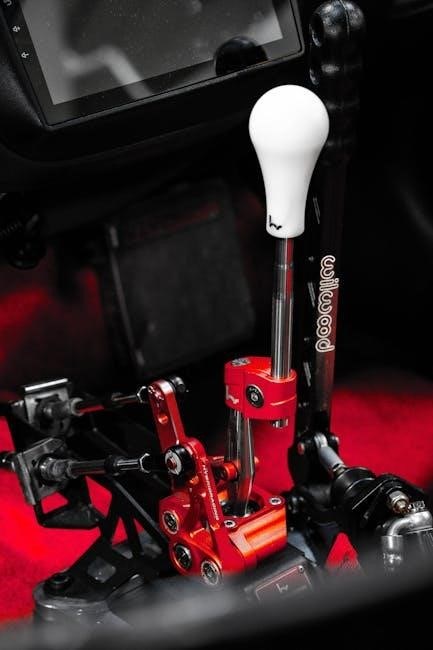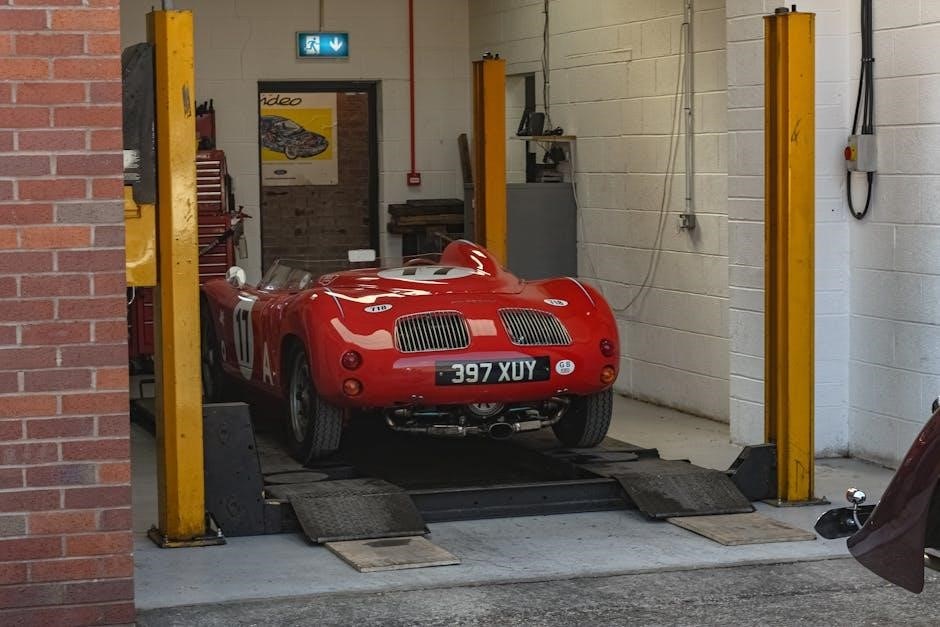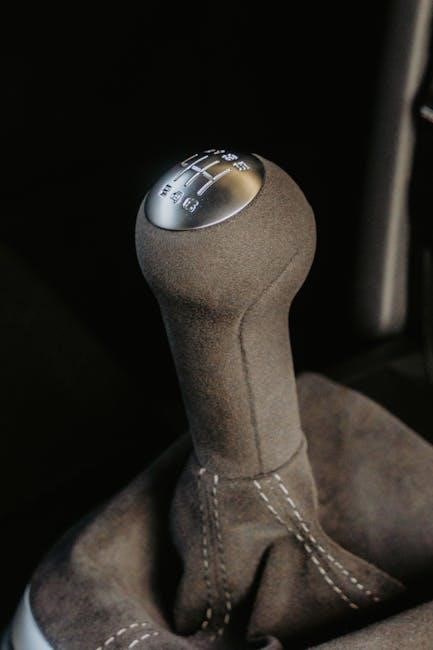Eight-speed manual transmissions demand active driver engagement, utilizing a clutch and gearshift, differing from automatic systems. These systems offer unique performance characteristics.
Today is 11/25/2025 10:40:30 ().
What is a Manual Transmission?
A manual transmission, at its core, is a gearbox that allows a driver to manually select different gear ratios, effectively controlling the engine’s output to the wheels. Unlike automatic transmissions which handle this process autonomously, a manual system requires direct driver input via a clutch pedal and a gearshift lever.
This direct control is fundamental to the driving experience, offering a heightened sense of connection with the vehicle. The driver disengages power from the engine using the clutch, selects the desired gear, and then re-engages power, coordinating these actions for smooth transitions.

While traditionally featuring 5 or 6 speeds, advancements have led to the development of 8-speed manual gearboxes, offering a wider range of ratios for optimized performance and efficiency. These systems, though less common, cater to enthusiasts seeking ultimate control.
The Rise of 8-Speed Manuals
The emergence of 8-speed manual transmissions represents a fascinating evolution in automotive engineering, driven by the pursuit of both performance and efficiency. Initially found in specialized vehicles, their adoption signifies a desire to maximize the potential of manual gearboxes.
Unlike traditional 5 or 6-speed manuals, an 8-speed configuration offers closer gear ratios. This allows the engine to consistently operate within its optimal power band, enhancing acceleration and responsiveness. The shorter gears are designed to keep the RPMs higher, maximizing the car’s power.
Companies like Tremec have been instrumental in developing these advanced systems, catering to both sports car applications and demanding industrial needs. This rise reflects a continued appreciation for driver engagement and control.

How an 8-Speed Manual Gearbox Works
An 8-speed manual gearbox relies on a driver-operated clutch and gearshift to actively select ratios, transferring engine power to the wheels efficiently.
Today is 11/25/2025 10:40:30 ().
Core Components of the System
The 8-speed manual gearbox fundamentally comprises several key components working in harmony. The transmission case houses all internal parts, providing structural support and lubrication. Gears themselves, of varying sizes, dictate the transmission ratio, influencing speed and torque. A robust input shaft receives power from the engine, while the output shaft delivers it to the drivetrain.
Crucially, synchronizers facilitate smooth gear changes by matching the speeds of the gears before engagement. The shift forks, controlled by the gearshift lever, move the synchronizers. A durable clutch disengages the engine from the transmission, enabling gear selection. Finally, the gear selector mechanism translates driver input into precise gear changes, ensuring optimal performance and control.
Today is 11/25/2025 10:40:30 ().
The Role of the Clutch
The clutch is a pivotal component within the 8-speed manual gearbox, acting as the crucial link between the engine and the transmission. Its primary function is to temporarily disconnect the engine’s power from the drivetrain, allowing the driver to smoothly change gears without damaging the transmission.
When the clutch pedal is depressed, it disengages the pressure plate from the clutch disc, interrupting power flow. This enables the driver to select a different gear. Releasing the pedal re-engages the clutch, gradually transmitting power. A properly functioning clutch is essential for smooth starts, shifts, and overall driving experience. It prevents stalling and ensures controlled power delivery.
Today is 11/25/2025 10:40:30 ().
Gear Ratios and Their Impact
Gear ratios within an 8-speed manual transmission are meticulously calculated to optimize performance and efficiency. Lower gears (like first) provide higher torque multiplication for acceleration, while higher gears (like eighth) offer lower engine speeds for fuel economy during cruising.
An 8-speed’s closer ratios mean the engine stays within its optimal power band more frequently. For example, a typical first gear ratio for a BMW 8-speed auto is 4.7:1. These ratios influence acceleration, top speed, and overall drivability. Shorter gears allow quicker responses, while taller gears enhance highway efficiency. The careful selection of these ratios is key to maximizing the transmission’s potential.
Today is 11/25/2025 10:40:30 ().
Synchronizers and Smooth Shifting
Synchronizers are critical components within an 8-speed manual gearbox, enabling smooth and effortless gear changes. They work by matching the rotational speed of the gear being selected with the speed of the main shaft before engagement. This prevents grinding and jarring, contributing to a refined driving experience.
Without synchronizers, shifting would be difficult and damaging to the transmission. Modern 8-speed manuals employ advanced synchronizer designs for quicker and more precise shifts. These systems minimize power interruption during gear changes, enhancing performance. A well-maintained synchronizer system is essential for the longevity and smooth operation of the gearbox, ensuring a pleasurable driving experience.
Today is 11/25/2025 10:40:30 ().

Advantages of an 8-Speed Manual Transmission
Eight-speed manuals provide enhanced performance, improved fuel efficiency, and a heightened level of driver engagement and control over the vehicle’s power delivery.
Today is 11/25/2025 10:40:30 ().
Enhanced Performance and Acceleration
An 8-speed manual gearbox significantly impacts a vehicle’s performance profile, particularly in acceleration. The closer gear ratios allow the engine to consistently operate within its optimal power band, maximizing output. Unlike a 6-speed, the shorter gears keep the revolutions per minute (RPM) higher during shifts.
This is especially beneficial for quicker acceleration, as drivers can utilize manual mode to maintain higher RPMs before each gear change. The transmission’s design ensures power is readily available, translating to a more responsive and exhilarating driving experience. The ability to precisely control engine speed contributes to faster 0-60 mph times and improved overall responsiveness.
Today is 11/25/2025 10:40:30 ().
Improved Fuel Efficiency
An 8-speed manual transmission can contribute to improved fuel efficiency through its wider range of gear ratios. These ratios allow the engine to operate at its most efficient RPM across a broader spectrum of speeds. By keeping the engine within this optimal zone, fuel consumption is minimized.
The closer gear spacing enables drivers to select the most appropriate gear for any given driving condition, reducing unnecessary engine load. This is particularly noticeable during highway cruising, where a higher gear can lower RPMs and conserve fuel. While driver skill is crucial, the 8-speed’s design facilitates efficient driving habits, leading to better mileage.
Today is 11/25/2025 10:40:30 ().
Driver Engagement and Control
An 8-speed manual gearbox fundamentally places the driver in control of the vehicle’s performance. Unlike automatic transmissions, it requires active participation in gear selection, fostering a direct connection between driver input and vehicle response. This hands-on experience is highly valued by driving enthusiasts.
The increased number of gears allows for more precise control over engine RPM, enabling drivers to optimize power delivery for various situations. This level of control is particularly appreciated in performance vehicles, where maximizing acceleration and handling is paramount. The driver dictates the driving experience, rather than relying on automated systems.
Today is 11/25/2025 10:40:30 ().

Comparison with Other Transmission Types
Eight-speed manuals contrast with 6-speed, automatics, and sequential types, offering unique advantages in control and gear ratios for varied driving scenarios.
Today is 11/25/2025 10:40:30 ().
8-Speed Manual vs. 6-Speed Manual
Comparing an 8-speed manual to a 6-speed reveals key differences in gearing strategy. While both require driver engagement, the 8-speed utilizes closer gear ratios, maintaining the engine within its optimal power band more consistently.
An 8-speed doesn’t simply add two gears; it redesigns the overall range. The first five gears often mirror a 5-speed’s coverage, but with shorter steps. This allows for quicker acceleration and more precise control, especially during spirited driving. A 6-speed might offer a wider gap between gears, potentially sacrificing some responsiveness.

Furthermore, the additional gears in the 8-speed contribute to improved fuel efficiency by enabling the engine to operate at lower RPMs during cruising. This nuanced control provides a balance between performance and economy, a characteristic not always achievable with a 6-speed configuration.
Today is 11/25/2025 10:40:30 ().
8-Speed Manual vs. Automatic Transmissions
The fundamental distinction between an 8-speed manual and an automatic lies in driver control; Manuals demand active gear selection via the clutch and shifter, offering a direct connection to the powertrain, while automatics handle shifting autonomously.
Automatics prioritize convenience, but traditionally sacrifice some efficiency and engagement. Modern automatics, particularly those with eight speeds, have narrowed this gap, offering quicker shifts and improved fuel economy. However, a manual allows the driver to precisely control engine RPMs for optimal performance.
Choosing between the two often depends on driving preference and intended use. For enthusiasts seeking a visceral experience and maximum control, the 8-speed manual remains compelling. For everyday commuting and ease of use, an automatic provides a smoother, less demanding experience.
Today is 11/25/2025 10:40:30 ().
8-Speed Manual vs. Sequential Manual Transmissions
Sequential manual transmissions (SMTs) differ significantly from traditional 8-speed manuals, despite both requiring manual gear selection. SMTs, often found in specialized vehicles, simplify shifting to an up-and-down motion, eliminating the need for a traditional H-pattern shifter.
An 8-speed manual offers a wider range of gear ratios, potentially enhancing both acceleration and fuel efficiency across diverse driving conditions. SMTs prioritize rapid gear changes, often employing automated clutch operation for quicker lap times in racing applications.
While both demand driver involvement, the 8-speed manual provides a more nuanced and connected driving experience. SMTs trade some of that feel for sheer speed and simplicity, making them ideal for performance-focused scenarios where lightning-fast shifts are paramount.
Today is 11/25/2025 10:40:30 ().

Applications of 8-Speed Manual Gearboxes
Eight-speed manuals excel in sports cars, performance vehicles, and even agricultural equipment, with companies like Tremec providing robust solutions for diverse applications.
Today is 11/25/2025 10:40:30 ().
Sports Cars and Performance Vehicles
Eight-speed manual gearboxes are increasingly favored in the realm of sports cars and high-performance vehicles, offering a compelling blend of control and efficiency. These transmissions allow drivers to maximize engine power and maintain optimal RPM ranges for exhilarating acceleration.
The shorter gear ratios inherent in an 8-speed design, compared to traditional 6-speed setups, contribute to quicker shifts and improved responsiveness. A typical first gear ratio, like the 4.7:1 found in some BMW applications, provides substantial torque multiplication.
This is particularly beneficial for vehicles prioritizing track performance or demanding driving experiences. The enhanced driver engagement and precise control offered by a manual transmission, combined with the expanded gear range, make 8-speed manuals a popular choice for automotive enthusiasts seeking a truly connected driving experience.
Today is 11/25/2025 10:40:30 ().
Specific Examples: BMW and Tremec

BMW has notably integrated 8-speed automatic transmissions, often with manual shifting modes, into several performance models, showcasing the potential for optimized gear ratios. These systems frequently employ a 4.7:1 first gear, maximizing torque output. However, true 8-speed manuals are less common, highlighting the complexity of development.
Tremec, a leading transmission manufacturer, produces a range of high-quality manual gearboxes suitable for diverse applications, including performance cars and industrial machinery. They are known for their robust construction and ability to handle significant torque.
Tremec’s offerings cater to both restoration projects and custom builds, providing enthusiasts with reliable and durable manual transmission solutions. Their products demonstrate the continued demand for manual transmissions, even as automatic technology advances, offering a direct connection between driver and machine.
Today is 11/25/2025 10:40:30 ().
Agricultural and Industrial Applications
Eight-speed manual gearboxes aren’t limited to automotive applications; they find crucial roles in agricultural and industrial machinery where precise control and high torque are paramount. These transmissions are frequently utilized in tractors, combines, and other heavy-duty equipment, offering a wide range of speeds for various tasks.
Tremec, recognized for its durable transmissions, supplies robust manual gearboxes designed to withstand the demanding conditions of agricultural and industrial environments. These units often feature reinforced components and heavy-duty clutches to handle substantial loads.
The multiple gear ratios allow operators to optimize power delivery for plowing, harvesting, or material handling, enhancing efficiency and productivity. The direct mechanical connection provides reliable performance and minimizes power loss, crucial in these applications.
Today is 11/25/2025 10:40:30 ().

Maintenance and Troubleshooting
Regular checks and fluid changes are vital for 8-speed manuals. Common issues include clutch wear and shifting problems, requiring qualified mechanic attention.
Today is 11/25/2025 10:40:30 ().
Common Issues and Their Solutions
Several issues can arise with an 8-speed manual gearbox. Difficulty shifting often points to a worn clutch, low transmission fluid, or issues with the synchronizers. Grinding noises during gear changes frequently indicate synchronizer problems, requiring inspection and potential replacement.
Clutch slippage, manifesting as engine revving without corresponding acceleration, signals clutch wear and necessitates replacement. Leaks around the transmission housing suggest seal failures, demanding immediate attention to prevent fluid loss and potential damage.
Sticking gears can sometimes be resolved with a thorough fluid change, utilizing the manufacturer’s recommended lubricant. However, persistent issues may indicate internal damage, requiring professional diagnosis and repair. Ignoring these symptoms can lead to more extensive and costly repairs down the line.
Today is 11/25/2025 10:40:30 ().
Regular Maintenance Procedures
Consistent maintenance is crucial for the longevity of an 8-speed manual gearbox. Fluid checks should occur every 30,000 miles, ensuring proper lubrication and preventing wear. Fluid changes, using the manufacturer’s specified type, are recommended every 60,000 miles or three years, whichever comes first.
Inspect the clutch for signs of wear or slippage during routine servicing. Check the shift linkage for smooth operation and adjust as needed. Regularly examine the transmission housing for any leaks, addressing them promptly to avoid fluid loss.
Proper driving habits, such as avoiding harsh shifting and “riding” the clutch, contribute significantly to gearbox health. Maintaining a detailed service record helps track maintenance intervals and identify potential issues early on, preventing costly repairs.
Today is 11/25/2025 10:40:30 ().
Finding Qualified Mechanics
Locating a mechanic experienced with 8-speed manual gearboxes is vital for accurate diagnosis and repair. Not all technicians possess the specialized knowledge required for these complex systems.
Seek out shops specializing in performance vehicles or those with a proven track record servicing European cars, as these often encounter such transmissions. Online reviews and referrals from car enthusiasts can provide valuable insights.
Verify certifications like ASE Master Technician, indicating a high level of skill and training. Don’t hesitate to ask about the mechanic’s specific experience with manual transmissions and clutch work before entrusting them with your vehicle. A knowledgeable technician ensures proper repairs and avoids further damage.
Today is 11/25/2025 10:40:30 ().

The Future of Manual Transmissions
Despite automotive trends, manual gearboxes retain appeal for driver engagement. Eight-speed manuals may find niche applications in performance cars, preserving a connected driving experience.
Today is 11/25/2025 10:40:30 ().
Trends in Automotive Technology
The automotive landscape is rapidly evolving, dominated by electrification and the rise of sophisticated automatic transmissions. However, these advancements don’t necessarily signal the complete demise of manual gearboxes, even those with eight speeds. A key trend is the increasing complexity of automatic transmissions, sometimes mirroring the gear counts of manuals to optimize efficiency and performance.
Furthermore, the demand for driver-focused experiences persists, creating a counter-trend where enthusiasts actively seek vehicles offering a direct connection to the drivetrain. While fully autonomous driving gains traction, a segment of drivers will continue to value the control and engagement provided by a manual transmission;
The integration of technology, like rev-matching assist, could potentially bridge the gap, making eight-speed manuals more accessible to a wider range of drivers without sacrificing the core experience. Ultimately, the future likely holds a coexistence of various transmission types, catering to diverse preferences and driving needs.
Today is 11/25/2025 10:40:30 ().
The Continued Appeal of Manual Gearboxes
Despite the prevalence of automatics, the eight-speed manual gearbox retains a dedicated following, fueled by a desire for a more immersive driving experience. Purists appreciate the direct mechanical link between driver and machine, fostering a sense of control often absent in automated systems. This connection extends beyond performance, offering a tactile and engaging interaction with the vehicle.
The eight-speed configuration specifically enhances this appeal by providing a wider range of gear ratios, optimizing both acceleration and fuel efficiency. For enthusiasts, the ability to select the precise gear for any situation is paramount.
Moreover, the manual transmission remains a symbol of driving skill and passion, attracting those who relish the challenge and reward of mastering a complex system. This enduring appeal suggests that, even in a technologically advanced automotive world, the manual gearbox will continue to thrive.
Today is 11/25/2025 10:40:30 ().
